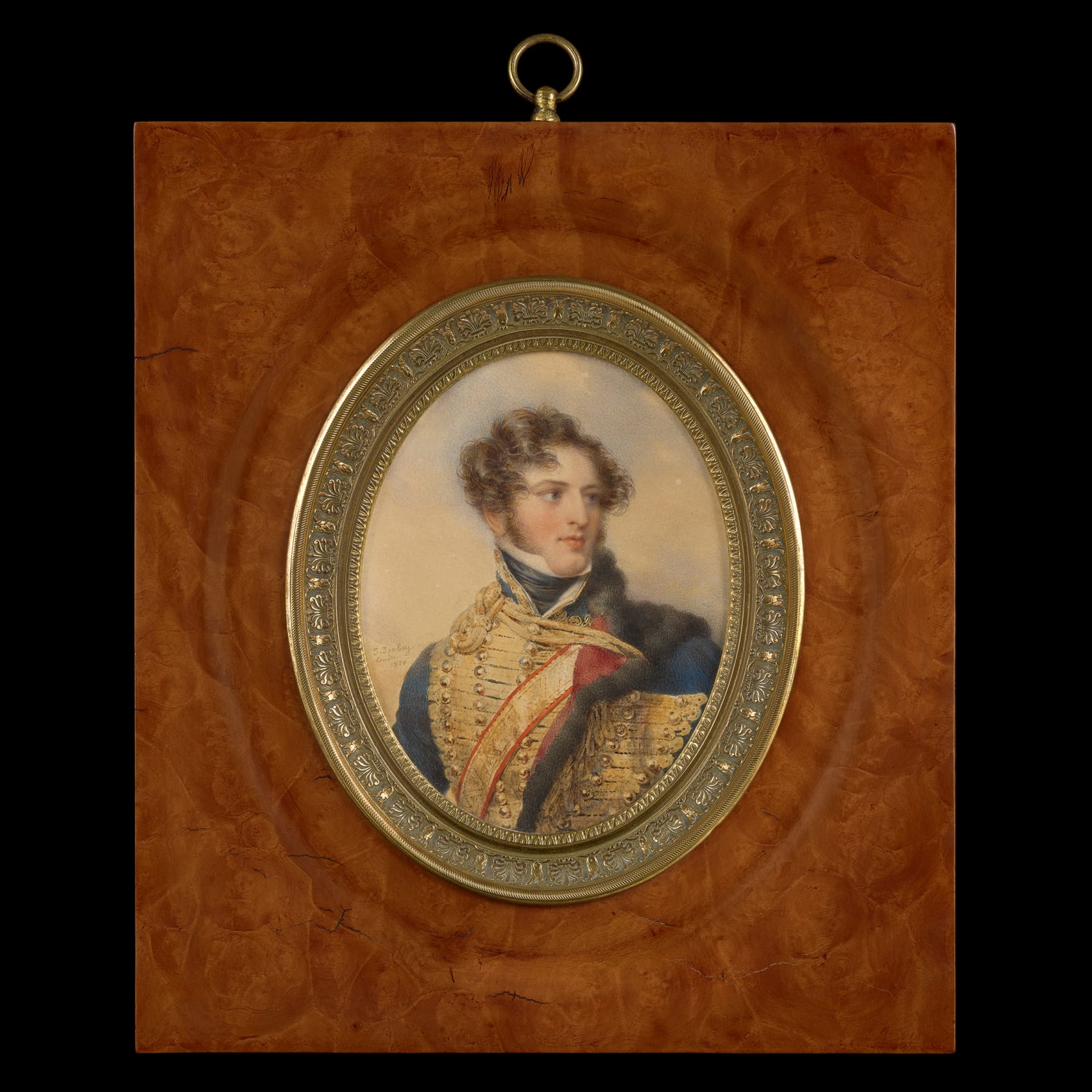
Jean Baptiste Isabey
(1767-1855) Frederick Charles William Seymour (1797-1856) wearing the uniform of the 7th Light Dragoons (Hussars)Provenance
Phillips, London, 6 November, 2000, lot 200;
with D. S. Lavender (Antiques) Ltd., London (2007);
Private Collection, UK.
Exhibitions
Malmaison, Musée national des Châteaux de Malmaison et Bois-Préau, Jean-Baptiste Isabey, portraitiste de l'Europe (1767-1855), 2005-2006.
Frederick Charles William Seymour was the son of Hugh Seymour and Horatia (née Waldegrave)and a grandson of Francis Seymour-Conway, 1st Marquess of Hertford and Lady Isabella Fitzroy. He married, firstly, in 1822Lady Mary Gordon (d.1825); the couple had two children before her untimely death; Mary Frederica (d.1902) and Conway Frederick Charles (1823-1914). Seven years after Lady Mary's death, Frederick married Lady Augusta Hervey (d.1880), daughter of Frederick, 1st Marquess of Bristol and the couple had six children.Lady Hervey’s travel journals from 1817-19 are held at the British Library.
The French artist, Jean-Baptiste Isabey, painted members of the Seymour family (then one of the wealthiest families in the country) during a trip to London in 1820. Isabey was, by this time, internationally famous for his allegiance to both Marie-Antoinette and, later, Napoleon. The artist arrived in London in the spring of 1820, where he stayed with the Marquis d’Osmond, a military officer, who was also visiting from Paris. Isabey painted...
Frederick Charles William Seymour was the son of Hugh Seymour and Horatia (née Waldegrave)and a grandson of Francis Seymour-Conway, 1st Marquess of Hertford and Lady Isabella Fitzroy. He married, firstly, in 1822Lady Mary Gordon (d.1825); the couple had two children before her untimely death; Mary Frederica (d.1902) and Conway Frederick Charles (1823-1914). Seven years after Lady Mary's death, Frederick married Lady Augusta Hervey (d.1880), daughter of Frederick, 1st Marquess of Bristol and the couple had six children.Lady Hervey’s travel journals from 1817-19 are held at the British Library.
The French artist, Jean-Baptiste Isabey, painted members of the Seymour family (then one of the wealthiest families in the country) during a trip to London in 1820. Isabey was, by this time, internationally famous for his allegiance to both Marie-Antoinette and, later, Napoleon. The artist arrived in London in the spring of 1820, where he stayed with the Marquis d’Osmond, a military officer, who was also visiting from Paris. Isabey painted for the Duke of Wellington, who ironically had become a great friend of his, and it was Wellington recommended him to the Seymour family.
A man described as possessing great wit and charm, it seems that Frederick’s sister Mary and brother Horace sat for him at this time.[1]The portrait of Horace was exhibited London, South Kensington Museum, Special Exhibition of Portrait Miniatures, 1865, lent by The Dowager Countess Spencer and as 'one of the few miniatures painted by the artist during his short residence in England'.
In 1820, Isabey also exhibited in London his watercolour showing the delegates at the Congress of Vienna (who had met following Napoleon's abdication).The watercolour was commissioned by the French delegate at the Congress, Charles Maurice de Talleyrand, but remained in the possession of the artist until it was purchased by George IV in 1820 and remains in the Royal Collection to this day. Upon his return to France, Isabey was able to switch his allegiance once again and was commissioned by Louis XVIII.
This watercolour of Frederick, painted with Isabey’s customary blend of precision and energy, shows the young man with his head slightly turned as if in motion. A similar pose can be seen adopted by Prince August of Prussia, painted a few years earlier in 1814 (Wallace Collection). Painted in 1820, just prior to the sitter’s marriage, the portrait may have been commissioned for the Frederick’s mother or future wife. It is one of the most quixotic images painted by Isabey during his short sojourn in England.
[1]Isabey painted Mary Georgiana Emma (Seymour) Dawson-Damer (abt. 1798 - 1848), as well as their brother Colonel Sir Horace Beauchamp Seymour KCH (22 November 1791 – 23 November 1851), both in watercolour on card. Horace’s portrait by Isabey was also copied by the British artist William Egley in 1840 (sold Christie’s, London, 7-8 July 2010, lot 281).

